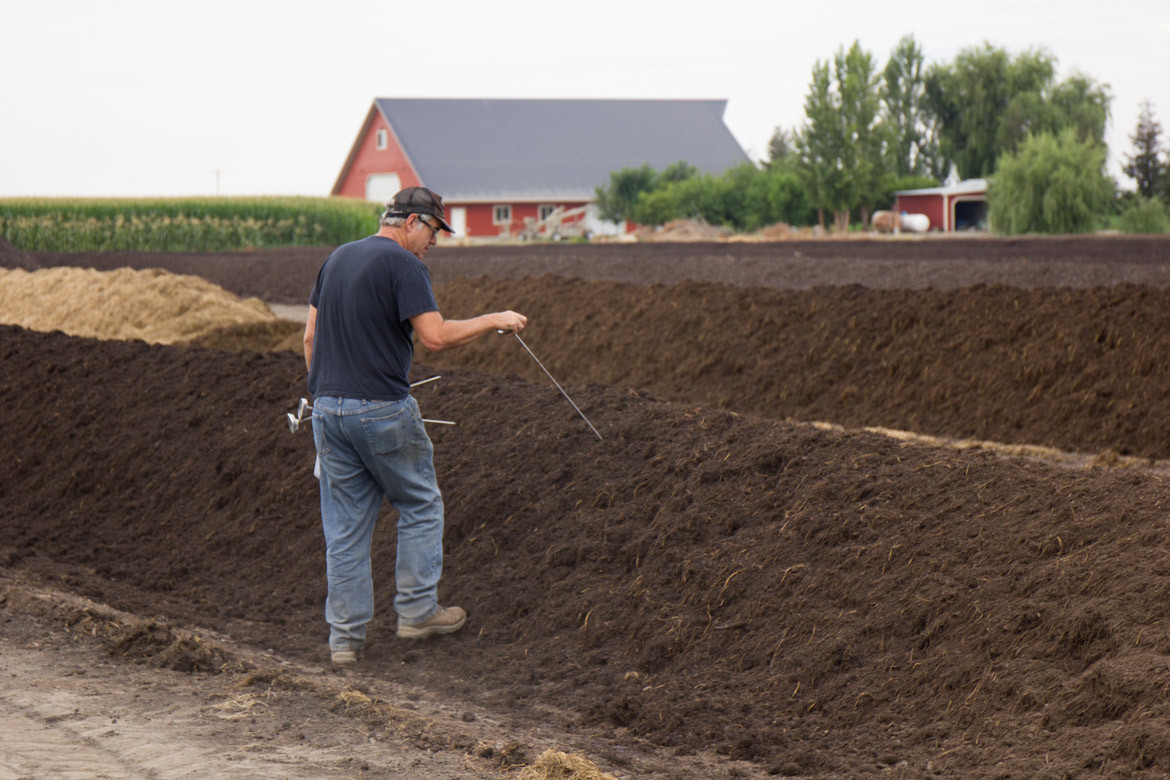
Compost biochar blends available in bulk, maybe near you.
Summary
Do you apply compost? Interested in biochar? Want something easy? (yes, these questions are teeing up a pitch) Pacific biochar can now offer compost biochar blends at multiple locations in California, and with the normal ease you can expect when adding lime or gypsum to your compost.
Here is a snapshot: Compost biochar blend at 10% biochar by weight, $95 per ton, or $80 per ton with biochar at 5% blend. That is the offering through one of the several compost facilities we are working with.
Consulting is available to help ensure success, and often with no charge for simple inquiries. But here is a basic breakdown of what is suggested:
- 5% to 10% biochar by weight for maintenance applications (annual side-dressings, nutrient additions, etc.).
- 25% biochar by weight for a new field prep or other rare and deep soil disturbances.
- Some of the facilities we work with offer co-composted blends, where the biochar was introduced as an amendment to the compost in the primary stages. Where this is not an option, allowing the compost biochar blend to “stew†for a few weeks can have positive effect and is suggested when practical.
Benefits of using biochar compost blends:
Better together.
It can be a mutually beneficial relationship; biochar can improve composting process, and simultaneously become improved itself. Reduction of nitrogen loss during composting is a notable benefit when compost is amended with biochar. In turn, the highly adsorbant surface of the biochar becomes “charged†up with humic acids, plant nutrients, and living microorganims.1
Nutrient conservation.
Plant nutrients are lost to groundwater through leaching and lost to the air through volatilization. This poses a loss of efficiency on the farm and an environmental problem beyond the fence. The United States Environmental Protection Agency (US EPA) has been quoted as saying: “Nutrient pollution is one of America’s most widespread, costly and challenging environmental problems, and is caused by excess nitrogen and phosphorus in the air and water.â€
Fertilizer efficiency has been notably improved after the application of biochar. This has been primarily observed as a reduction in the loss of plant nutrients. Analogous to the use of charcoal in filtration, biochar (a type of charcoal) can help hold onto plant nutrients in the topsoil. However, it is important to note that the majority of nutrients held by the biochar are still plant available—resistant to loss, yet still available for use.
Blending biochar directly with compost, for a single co-product application maximizes the nutrient conservation benefits of biochar.2
Water conservation.
Where biochar has been applied, soils show higher water-holding capacity, improved water retention, increased plant-available water, increased plant resilience in drought conditions, and greater crop productivity per unit of water. The crop yield benefits of adding biochar to agricultural practices can be seen in different ways:
- Under highly managed irrigation, an expected outcome would be reduction in amount of water needed.
- In systems that are limited in control, an expected outcome would be mitigating undesired crop stress.3
Microbial support.
The anatomical structure of the plant material used to make biochar—the vascular tissue of tubes and tunnels that were used to carry food and water throughout the plant body—remains largely intact during and after the production process of firing. The resulting biochar material is intricately structured, porous, resistant to decay, and carbon based, characteristics well suited to supporting microbial life. When biochar is used in soil, microbial communities are observed to be more diverse, active, and are found to fare better through adversity.4
Stable organic matter.
Organic matter is critical for soil function and soil quality. Charcoal (biochar) is a stable form of soil organic matter. It is naturally occurring and has been found to make up as much as 30% of the organic matter in soils such as the dark fertile soils of Iowa, and of the famously fertile manmade soils in the Amazon region called Terra Preta.
Using biochar provides a method of increasing soil organic matter in a way that is stable for centuries.5

Locations where biochar compost blends are available in bulk:
WM Earth Care
8950 Redwood Highway
Novato, CA 94948.
(415) 892-2851
*Organic compost and biochar blends available.
Andy Poncia Trucking / Poncia Fertilizer
597 Wilfred Ave.
Santa Rosa, CA 95407
(707) 481-8052
*Organic compost and biochar blends available. Wholesale only.
Sonoma Soil Builders
5900 Pruitt Ave.
Windsor, CA 95492
(707) 838-7645
*Organic compost and biochar blends available. Soil blends with biochar available.
West Marin Compost
5575 Nicasio Valley Rd.
Nicasio, CA
(415) 473-6717
*Organic compost, mulch, topsoil blends available with biochar.
The Worm Farm
9033 Esquon Rd.
Durham, CA 95938
(530) 894-1276
*Organic compost, worm castings, and premium soil blends available with biochar.
Compost Solutions
4446 County Road N
Orland, CA 95963
(530) 521-1616
*Organic compost and biochar blends available.
References:
1 C. Kammann et al., 2015. Plant growth improvement mediated by nitrate capture in co-composted biochar. Nature – Scientific Reports. 5:11080 | DOi: 10.1038/srep11080
Jindo et al., 2012. Chemical and biochemical characterisation of biochar-blended composts prepared from poultry manure. Bioresource Technology, Bioresource Technology 110 (2012) 396–404
Steiner C, Das KC, Melear N, Lakly D. Reducing nitrogen loss during poultry litter composting using biochar. J Environ Qual. 2010;39:1236–42.
2 Glaser, Bruno et al., 2015 Biochar organic fertilizers from natural resources as substitute for mineral fertilizers. Agronomy for Sustainable Development (2015) 35:667–678
Singh, Bhupinder Pal et al., 2013. Influence of Biochars on Nitrous Oxide Emission and Nitrogen Leaching from Two Contrasting Soils J. Environ. Qual. 39:1224–1235 (2010) doi:10.2134/jeq2009.0138
P.A. Trazzi et al., 2016. Adsorption and desorption of phosphate on biochars Journal of Environmental Chemical Engineering, Volume 4, Issue 1, March 2016, Pages 37–46
3 C. Kammann et al, 2011. Influence of biochar on drought tolerance of Chenopodium quinoa Willd and on soil-plant relations. Plant and Soil. 345:195-210, August 2011
Lorenzo Genesio et al., 2015. Biochar increases vineyard productivity without affecting grape quality: Results from a four years field experiment in Tuscany. Agriculture, Ecosystems, and Environment 201 (2015) 20-25
4 Cayuela, M.L. et al., 2013. Biochar and denitrification in soils: when, how much and why does biochar reduce N2O emissions? Sci. Rep. 3, 1732; DOI:10.1038/ srep01732 (2013).
Liang, Chenfei et al., 2014 Biochar alters the resistance and resilience to drought in a tropical soil Environmental Research Letters 9 (2014) 064013 (6pp)
O’Niell et al. 2011. Bacterial Community Composition in Brazilian Anthrosols and Adjacent Soils Characterized Using Culturing and Molecular Identification Microb Ecol (2009) 58:23–35
5 Heike Knicker (2011). Pyrogenic organic matter in soil: Its origin and occurrence, its chemistry and survival in soil environments. Quaternary International 243(2):251-263 · October 2011.
Budai et al., 2013. Biochar Carbon Stability Test Method: An assessment of methods to determine biochar carbon stability. International Biochar Initiative. September 20, 2013
CAPCOA GHG Rx Protocol: Biochar Production Project Reporting Protocol, GHG Emission Reduction Accounting (Approved by CAPCOA Board September 28, 2105)
CAPCOA GHG Rx Protocol Addendum: To the Biochar Production Project Reporting Protocol, GHG Emission Reduction Accounting, June 14, 2016 (Approved by the CAPCOA Board on August 31, 2016)






